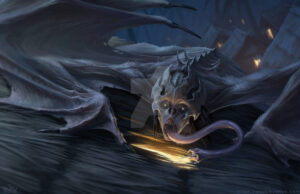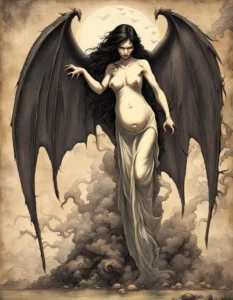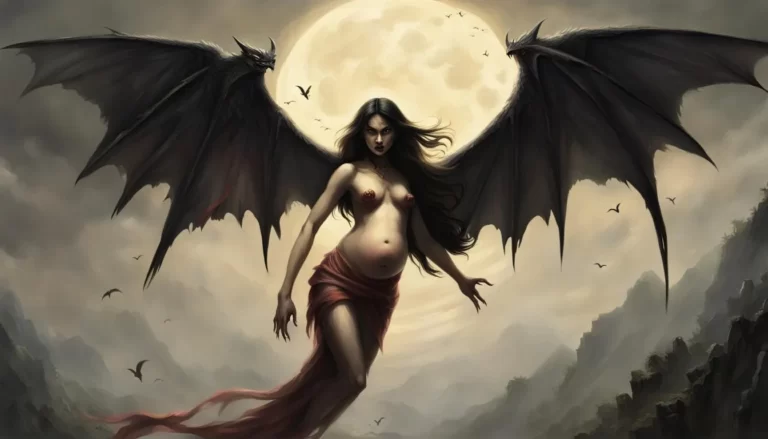Table of Contents
Legend has it that the Manananggal preys on pregnant women, using its long, proboscis-like tongue to suck the blood of the fetus or the heart of its victims. Additionally, it is said to have a particular aversion to garlic, salt, and sunlight. To ward off a Manananggal, people may place garlic, salt, or ash on the severed lower half of its body, preventing it from rejoining and becoming whole again.
The Manananggal is a popular figure in Filipino horror stories and has been featured in various films, books, and cultural references throughout the years. It is part of the rich folklore that reflects the Philippines’ cultural beliefs and traditions.
Origin

The origin of the Manananggal legend can be traced back to Philippine folklore, and the creature has been a prominent figure in the country’s traditional stories for many generations. The specific origins are not well-documented, as folklore tends to evolve over time through oral traditions and cultural exchanges. However, the Manananggal is deeply rooted in the mythology of the Philippines.
Many legends and folktales in the Philippines are shaped by a combination of indigenous beliefs, pre-colonial mythology, and influences from various cultures that have interacted with the archipelago over the centuries. The Manananggal’s characteristics, such as its ability to fly, detach its upper torso, and feed on the blood of victims, reflect elements commonly found in vampire lore worldwide.
The Manananggal has become an iconic creature in Filipino horror folklore, and its stories are often shared to both entertain and frighten. Over time, various versions of the legend have emerged, adding to the richness and diversity of Philippine folklore. The creature remains a cultural symbol and a source of inspiration in literature, film, and other forms of storytelling in the Philippines.
Physical Description
The Manananggal is typically described as a female monster with the ability to sever its upper torso from its lower body. Here are some common physical characteristics attributed to the Manananggal in Filipino folklore:
Bat-like Wings: One of the distinctive features of the Manananggal is its ability to sprout large, bat-like wings. These wings enable the creature to fly, especially during the night when it is said to be most active.
Proboscis or Long Tongue: The Manananggal is often depicted with a long, proboscis-like tongue that it uses to suck the blood of its victims. This tongue may be used to reach into houses or through small openings to access its prey.
Human Appearance: When not in its monstrous form, the Manananggal is said to have a human appearance, making it blend in with the community. This human guise allows it to hide its true nature from unsuspecting victims.
Detachable Torso: The most iconic feature of the Manananggal is its ability to separate its upper torso from its lower body. This allows it to leave its lower half behind while flying to seek out victims.
Aversion to Certain Substances: According to folklore, the Manananggal has an aversion to garlic, salt, and certain religious objects. People use these items as protective measures to ward off the creature.
The Manananggal is often portrayed as a malevolent and predatory creature in Filipino folklore. While it may assume a human appearance to blend in with society during the day, its true nature is revealed at night when it becomes a fearsome monster. Here are some aspects of the Manananggal’s personality as described in traditional stories:
Predatory Nature: The Manananggal is known for preying on humans, particularly pregnant women or sleeping individuals. It is said to have a particular attraction to unborn children and may use its long tongue to suck the blood of fetuses.
Stealth and Cunning: In its human form, the Manananggal is often depicted as sly and cunning, able to move among people without arousing suspicion. Its ability to detach its torso and fly gives it a stealthy advantage when seeking out victims.
Nocturnal Behavior: The Manananggal is primarily active during the night. It is believed to go on its hunting sprees under the cover of darkness, using its wings to fly to the homes of its victims.
Aversion to Certain Items: The creature is said to have a strong aversion to garlic, salt, and religious objects. People use these items as protective measures to ward off the Manananggal. The belief is that these substances act as deterrents or barriers against the creature.
Fear of Sunlight: Like many vampire legends, the Manananggal is often associated with a fear of sunlight. It is said to hide from the daylight, retreating to a safe place to avoid being exposed.
The personality traits of the Manananggal contribute to the fear and suspense associated with the creature in Filipino folklore. The stories surrounding the Manananggal serve as cautionary tales and are often shared to instill a sense of awareness and cultural values within the community.
Explanation of the Myth

The Manananggal myth is deeply ingrained in Philippine folklore, and its origins can be traced to a combination of cultural influences, superstitions, and a rich oral storytelling tradition. The myth serves various purposes within the cultural context, blending elements of horror, morality, and the supernatural. Here’s an overview of the key components of the Manananggal myth:
Supernatural Abilities: The Manananggal is known for its supernatural abilities, particularly the ability to sever its upper torso from its lower body and fly with bat-like wings. This distinctive trait sets it apart from other mythical creatures and contributes to the horror associated with its legend.
Predatory Behavior: The Manananggal is a predator, targeting vulnerable victims, often pregnant women or individuals who are asleep. Its nocturnal activities and preference for preying on the unborn or sleeping individuals heighten the fear associated with the creature.
Aversion and Protective Measures: The myth includes details about the Manananggal’s aversions, such as garlic, salt, and religious objects. These elements serve as protective measures against the creature. People use these items to ward off the Manananggal and protect themselves from its attacks.
Cultural Values and Morality: Like many folklore myths, the Manananggal story often carries moral lessons or reflects cultural values. It may emphasize the consequences of certain actions or behaviors, cautioning against the dangers of the night and the importance of protective measures.
Fear of the Unknown: The Manananggal myth plays on the fear of the unknown and the supernatural. Its ability to transform and the stealthy manner in which it preys on unsuspecting victims contribute to the sense of unease and horror associated with the creature.
Cultural Identity: The Manananggal is a cultural symbol, reflecting the unique identity of Philippine folklore. Its presence in stories, art, and media contributes to the preservation and continuation of cultural traditions and beliefs.
The Manananggal myth, like many folklore tales, has evolved over time through oral storytelling, regional variations, and cultural adaptations. It continues to be a prominent figure in Filipino horror folklore, inspiring creativity in literature, film, and other forms of artistic expression.
In Modern Usage and Symbolism

In modern usage and symbolism, the Manananggal has retained its status as a significant and iconic figure in Philippine culture, particularly in the realm of horror and popular media. Here are some ways in which the Manananggal is used and symbolized in contemporary contexts:
Horror Genre: The Manananggal remains a popular subject in Filipino horror films, television shows, and literature. It is often featured in stories that blend traditional folklore with modern storytelling techniques, catering to audiences who enjoy supernatural and horror genres.
Cultural Identity: The Manananggal is seen as a symbol of Philippine folklore and cultural identity. Its continued presence in modern media helps preserve and promote awareness of traditional beliefs and mythology among younger generations.
Art and Illustration: Artists and illustrators often incorporate the imagery of the Manananggal in their works. It serves as inspiration for creative expressions and contributes to the visual arts, allowing for a fusion of traditional folklore with contemporary artistic styles.
Pop Culture References: The Manananggal is occasionally referenced in popular culture outside the Philippines. Its unique characteristics, such as the ability to detach and fly, make it a distinctive and memorable creature that can be adapted into various cultural contexts.
Tourism and Folklore Promotion: The Manananggal, along with other mythical creatures from Philippine folklore, is sometimes used to promote cultural tourism. Folklore festivals and events may showcase traditional stories, costumes, and performances, attracting both local and international audiences.
Symbol of Fear: The Manananggal continues to symbolize fear and the unknown. Its portrayal in horror media contributes to the creation of suspenseful and frightening narratives, and it remains a figure that can evoke a sense of horror and intrigue.
Adaptation in Various Media: The Manananggal has made its way into various forms of media, including video games, comics, and other digital platforms. Its adaptability allows storytellers to explore new narratives and interpretations while keeping the essence of the creature intact.
Similar creatures
Manananggal persists in modern usage as a symbol that bridges traditional folklore with contemporary storytelling and artistic expression. Its significance extends beyond the boundaries of the Philippines, making it a unique and recognizable figure in the broader context of global mythologies and popular culture.
While the Krasue is unique to Thai folklore, there are similar creatures from various cultures around the world that share characteristics of a disembodied or floating head.
Chonchon (Chile): In Chilean mythology, the Chonchon is believed to be a sorcerer or witch who can transform into a flying, disembodied head with large ears that allow it to fly silently at night.
Cabeza Voladora (Mexico): In Mexican folklore, the Cabeza Voladora, meaning “flying head,” is a creature that appears as a decapitated head with bat-like wings. It is said to fly around at night, attacking and terrorizing those it encounters.
Kappa (Japan): While not exactly a flying head, the Kappa from Japanese folklore is a water creature that is sometimes depicted with a humanoid appearance but with a dish-like depression on its head. The dish must be filled with water, and if it spills, the Kappa loses its strength.
Nalusa Falaya (Choctaw Nation): In Native American Choctaw folklore, the Nalusa Falaya is a creature that appears as a disembodied head with sharp teeth. It is said to fly at night and can shape-shift into different forms.
Liderc (Hungary): In Hungarian folklore, the Liderc is a shape-shifting creature that can take various forms, including that of a fiery-headed being. It is associated with night terrors and nightmares.
FAQ
What is a Manananggal?
A mythical Filipino creature, a female vampire that can separate its upper torso to fly.
What does a Manananggal eat?
It is said to feed on the blood of sleeping individuals, particularly targeting pregnant women and their fetuses.
How do you pronounce Manananggal?
Pronounced as "mah-nah-nahng-gahl."
What does the Manananggal do?
It detaches its upper body to fly and preys on sleeping victims, often focusing on pregnant women and their unborn children.
Where did the Manananggal come from?
The Manananggal originates from Philippine folklore and mythology.
Why does the Manananggal eat fetuses?
In folklore, the Manananggal is drawn to the blood of the unborn, and it is said to have a preference for feeding on fetuses.
What is Manananggal in English?
In English, Manananggal is often translated as a "flying vampire" or "self-segmenter."
What is a Manananggal Aswang?
The term "Aswang" is a broader category of supernatural creatures in Filipino folklore, and the Manananggal is considered one type of Aswang.
What is the weakness of a Manananggal?
Folklore suggests that the Manananggal is repelled by garlic, salt, and religious objects. Placing these items near its lower body may prevent it from rejoining.
Is a Manananggal undead?
The Manananggal is often considered a type of supernatural being rather than undead, as it possesses a physical body that can separate.
What is similar to a Manananggal?
Similar creatures from other cultures include the Penanggalan (Malaysia), Krasue (Thailand), and Chonchon (Chile).
Can a Manananggal be male?
Traditionally, the Manananggal is portrayed as a female creature, and there is no prominent male equivalent in Filipino folklore.
What is a fun fact about the Manananggal?
In some stories, the Manananggal is said to have a remarkable singing voice, which it uses to lure potential victims.
Where does the Manananggal come from?
The Manananggal comes from Philippine folklore, deeply rooted in the country's cultural traditions and beliefs.
When did the Manananggal first appear in the world?
The exact origin is not well-documented, but the Manananggal has been a part of Philippine folklore for generations, passed down through oral traditions.





